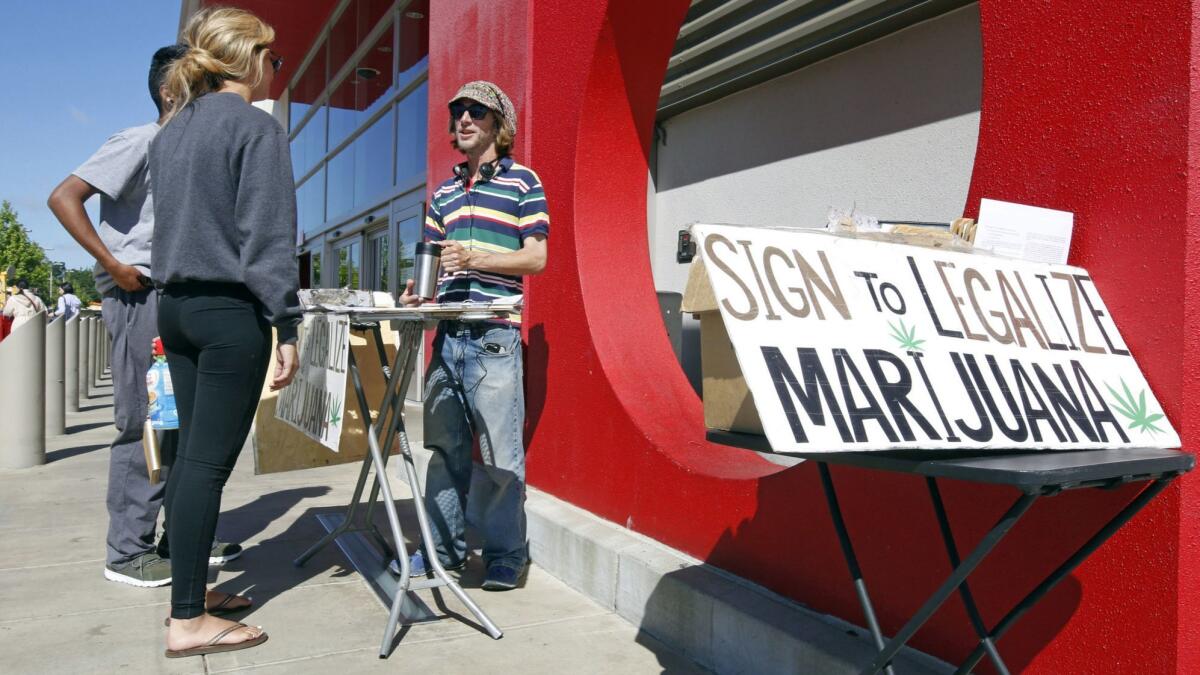Column: That ballot measure you’re signing now might not be seen until 2020

Reporting from Sacramento — In the home stretch of this year’s ballot initiative season, don’t be surprised if you’re asked to sign a petition for a proposal that won’t actually go to California voters until election day on Nov. 3, 2020.
That’s almost two years ahead of the normal schedule. In politics, as in life, a good deal can be hard to pass up.
The key to all of this is a little-known provision of the California Constitution that links the initiative process to the election of a governor. The number of voter signatures needed to place a measure on the ballot is a fixed percentage of the total votes cast in the most recent governor’s race. Right now, those numbers are based on how many voters showed up in 2014. That means it takes 365,880 signatures for a proposed law, 585,407 signatures for a constitutional amendment.
The election four years ago had record-low turnout and the fewest number of votes cast in a race for governor since 1978. It helps to explain why so many groups were able to get an initiative on the fall ballot two years ago.
All of that gets readjusted in November when voters pick a new governor. But any initiative that hits the streets for signatures before that person is elected gets to use the historically low threshold set in 2014 — even if it ends up on the 2020 ballot along with initiatives drafted in future years, and thus subject to a higher hurdle.
It should be noted it’s rare for a ballot initiative to be held over. And when it does happen, that’s generally seen as a campaign mistake. A hospital fee measure intended for the 2014 ballot, for example, was delayed until 2016 because backers submitted their signatures too late for the verification process to end on time.
In the case of 2018 initiatives headed for the 2020 ballot, it would be an effort to slow the political clock, shrewdly straddling the various deadlines that typically segment initiative efforts into two-year blocks of time.
Even Democratic lawmakers who agreed to Proposition 70 are trying to kill it »
Fewer signatures needed also mean less money spent — perhaps up to $1 million in reduced signature-collection costs. An extra bonus: State law generally requires propositions be listed on the ballot in the order in which they were certified by elections officials. Researchers have long believed that items toward the top of a ballot tend to fare better.
Last week, the healthcare workers union SEIU-UHW confirmed one of the group’s pending initiatives — a tax on incomes above $1 million to fund healthcare programs — is actually aimed for the fall ballot in 2020. “It’s kind of a clear field,” said spokesman Sean Wherley.
Will others follow? One other intriguing initiative — an effort to crack open the legendary property tax limitations of Proposition 13 by allowing more frequent reassessments of commercial property — got a late start for 2018. A political strategist working on the effort insists it’s for this year’s ballot, not 2020.
They’ll need to hurry. State elections officials have said that all signature gathering be completed by late April in order for the verification process to be complete by the final deadline for the fall, June 28. The progressive group behind that so-called “split roll” tax measure will need every dollar it can get to run the actual campaign. Business and corporate groups see the attempt to roll back their property tax protections as the Holy Grail of ballot fights and will spend heavily to defeat it.
With time running out for 2018, it soon will be crystal clear which efforts are part of the long game for 2020. It certainly must be enticing because it may never again be this easy to get the attention of that many voters.
Follow @johnmyers on Twitter, sign up for our daily Essential Politics newsletter and listen to the weekly California Politics Podcast
ALSO:
Updates on California politics
More to Read
Get the L.A. Times Politics newsletter
Deeply reported insights into legislation, politics and policy from Sacramento, Washington and beyond. In your inbox three times per week.
You may occasionally receive promotional content from the Los Angeles Times.











